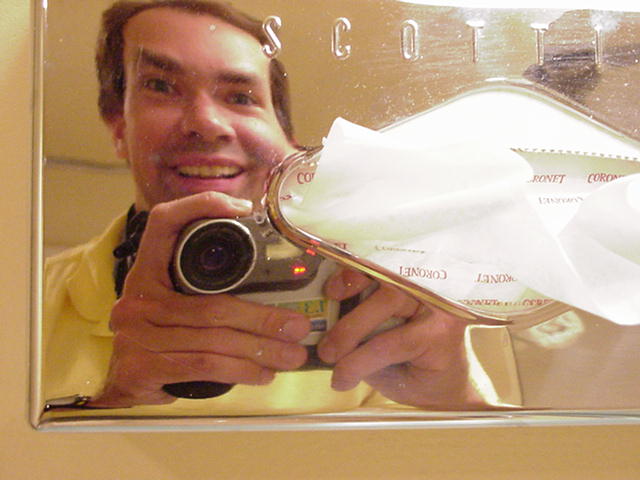Sony
Mavica MVC-FD88
© 2005 KenRockwell.com
Introduction
|
I personally buy from Ritz, Adorama and Amazon. I can't vouch for any other ads.
|
The FD88 came out in 1999. On February 29th, 2000 I bought a refurbished unit through a freind at Sony for the then-bargain price of $600. It worked great and has a 10x zoom, enough to let me make this shot the morning it arrived:

Hawk, La Jolla Mesa Estates, 29 February 2000.
I used it as my first digital camera until I bought my Nikon D1H in February 2002.
The Mavica can make great pictures. See this Mono Lake Gallery shot entirely at my FD-88's lowest reslution setting!
The rest of this artical is historic from the early 2000s.
The FD-88 is from about 1999-2000. The current equivalent model is the FD-92. Here is the rest of the current line of Mavica cameras.
This camera records photos on common floppy discs that sell for about 20 cents each if you don't have them lying around anyway.
It essentially is a high-definition Sony video camera set up to record stills. Autofocus and everythng is done directly through the lens, unlike the more primitive digital cameras from other makers that are really just film point-and-shoot cameras half-converted. Those film cameras use more primitive passive or active focus mechanisms that don't look through the taking lens, and prevent you from getting a lot of the trick macro and scanning modes that the FD-88 does.
You get about 24 640 x 480 pictures, or about five 1,280 x 960 pictures on a disk. The camera has an 8 power true optical zoom (in addition to a 2x digital zoom) that reaches out to the equivalent of a 400mm lens on a 35mm camera.
This Mavica even can format and copy entire disks or selected pictures, so you can give your friends copies of pictures while you are still making them without needing any computer.
In fact, if you are happy seeing pictures on the camera's screen or your own TV then you have no need for a computer, since their is a cord to plug the camera into most modern TVs' video input jacks. For this you never even need to use the higher resolutions, since TV resolution is right around 640 x 480.
Discs are cheap: I'm still using all the throwaway floppies I used to use for backups. I have not had to buy new ones. I keep a dozen with the camera, and copy them into my computer when I can.
I can back up all the photos I've made with this camera over the past year and a half on one CD.
Performance
A great thing about a digicam is that you can see the actual results over the Internet no problem. For now just look at the product and illustration photos around all my tech and review pages. These were all made with this camera. Another great thing about it is that it will make simultaneous 320 x 240 images along with the full sized ones, saving me time making little images for these pages.
See these images made straight from the FD88 at the lowest 640x480 resolution.
All these idiotic videos were also made on the FD-88 at the lowest resolution.
I have to use a lens as big as the one you see on my home page to get as close in 35mm as the FD-88 does all by itself. The FD-88 is excellent for tight zooms of wildlife. I bought it for fun, not ultimate image quality. I keep it set down at 640 x 480 for emailing.
See Steve's review here.
All the art you see on my site was done on FILM, not digital.
Flash and low light photography
I have not had problems with red eye, but that's because photographers who know know not to use flash indoors.
I use flash outdoors with sun and people to fill in shadows. I avoid flash indoors.
The FD-88 is very sensitive to light and rarely needs flash indoors. If you are deliberately hitting the flash button indoors, stop. Press it a couple of times so you see neither the flash or no flash icons in good light. This (standard) mode allows the camera turns the flash on only when it is so very dark that one needs it. Using this mode you will rarely see the camera use flash. If it is so dark that the camera wants flash (indicated with a Flash icon showing up on the LCD when you partially press the shutter button) I hit the "no flash" button instead.
If it's very dark I then hit the PROGRAM button a few times and select the single candle icon, which gives a longer exposure so I don't need to use flash. Using the flash indoors hides all the natural light of the scene. Red eye has mostly to do with the closeness of the flash to the lens. To eliminate red eye you'd need to have a camera with the flash off the camera.
Here are low-light photos made without flash, at the lowest 640 x 480 resolution:
Made in the longer exposure mode (one candle showing after hitting Program button.)
Comparison to the FD-83
I also tried the FD-83 The FD-88 was sharper for the same image size, and the FD-83 was better in low light. I prefer the more expensive FD-88 for its huge zoom range. I love the 8x zoom lens.
File sizes
A great thing about the FD-88 is that the standard quality 640 x 480 images are perfectly sized, both in pixels and in kB, for the Internet and emailing. A typical 640 x 480 file is 50kB.
The file size will vary wildly with the image. A flat wall may be only 20kB, and a very heavily textured scene like a backlit bare tree may be 120kB, all at 640 x 480. The camera uses the optimum compression for each image, and therefore each image will have a different file size. This is very good.
1024 x 768 images are about 125kb, and 1,280 x 960 images are about 225kB each, again depending wildly on the subject of your photo.
The "email" sized files are 320 x 240 pixels and are 10kB each. You can get one of these little files at the same time as one of the other sized files by selecting EMAIL as the mode from one of the menus. You cannot only shoot in this mode, just as well.
Macro mode
The macro mode automatically focusses right up to about an inch in front of the lens. You'll love it.
Slide and print scanning
You can cheat: the macro mode allows you to point the camera at prints and slides and make instant "scans" that look fine for letting people see what you're doing.
The macro mode is good enough that you can get a 35mm slide to fill the frame without needing to point the camera through a loupe.
Of course "scanning" 120, 4x5 and 8x10 transparencies is easy.
Just lay out your transparencies on your light table and you can "scan" them as fast as you can take pictures with the FD-88. That's way faster than a real scanner!
Recommendations
Go get one of these. The image quality is great for its intended purpose of screwing around on the internet.




